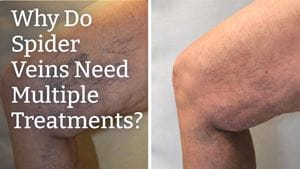
Many patients ask why they need several treatments for spider veins. Cosmetic sclerotherapy, a minimally-invasive procedure designed to improve the appearance of spider veins, generally requires multiple treatments.
Why can't treatment be complete in only one session? To help you understand spider vein treatment, let's first talk about what spider veins truly are.
Spider veins are characterized by a web of dilated veins most often found in the legs, though they can appear anywhere on the body. They resemble a spider web or thin tree branches that are either red, purple, or blue.
Spider veins are commonly found with varicose veins, which are blood vessels that have filled with pooled blood, but can be isolated as well. Although similar in appearance, spider veins and varicose veins are not the same.
Spider veins are smaller (less than 1 mm) and are generally asymptomatic and only a nuisance aesthetically, although they can occasionally cause itching, burning, or stinging. However, unlike varicose veins, treatment for spider veins is typically considered cosmetic and is not usually covered by insurance.
Spider veins are thought to be hereditary and occur more often in women than in men. They are frequently caused by various life conditions such as:
Spider veins occur most often around ages 30-50, but increase with age. Cosmetic sclerotherapy has proven to be the most effective solution to treat spider veins, known as the medical gold standard, even earning an 88 percent Worth It rating within the last 24 months.
During cosmetic sclerotherapy, a specialized solution called a sclerosing solution is injected directly into the problematic spider vein via a very tiny needle. The solution irritates the vein lining, causing fibrosis, and thereby closing the vein. The vein typically disappears in 2-6 weeks.
The number of treatments necessary to clear spider veins depends on the individual. In most cases, patients need 2-5 treatments to completely eliminate the appearance of spider veins. If the spider veins are bigger and more prevalent, additional treatments may be necessary. If new spider veins appear, patients will have to revisit their vein doctor.
Always discuss the procedure with your vein specialist before it begins. Spider veins require a slightly different treatment than varicose veins. Vein doctors generally treat underlying venous reflux and perforator venous reflux that contributes to the cause of the spider veins prior to actually performing cosmetic sclerotherapy. This will help prevent spider veins from coming back after treatment and potentially lessen the number of treatment sessions.
If you're still not sure if cosmetic sclerotherapy will benefit you and how many treatments you'll need, set up a consultation with your vein doctor. A professional vein specialist will be able to tell you if cosmetic sclerotherapy is a good option for you.